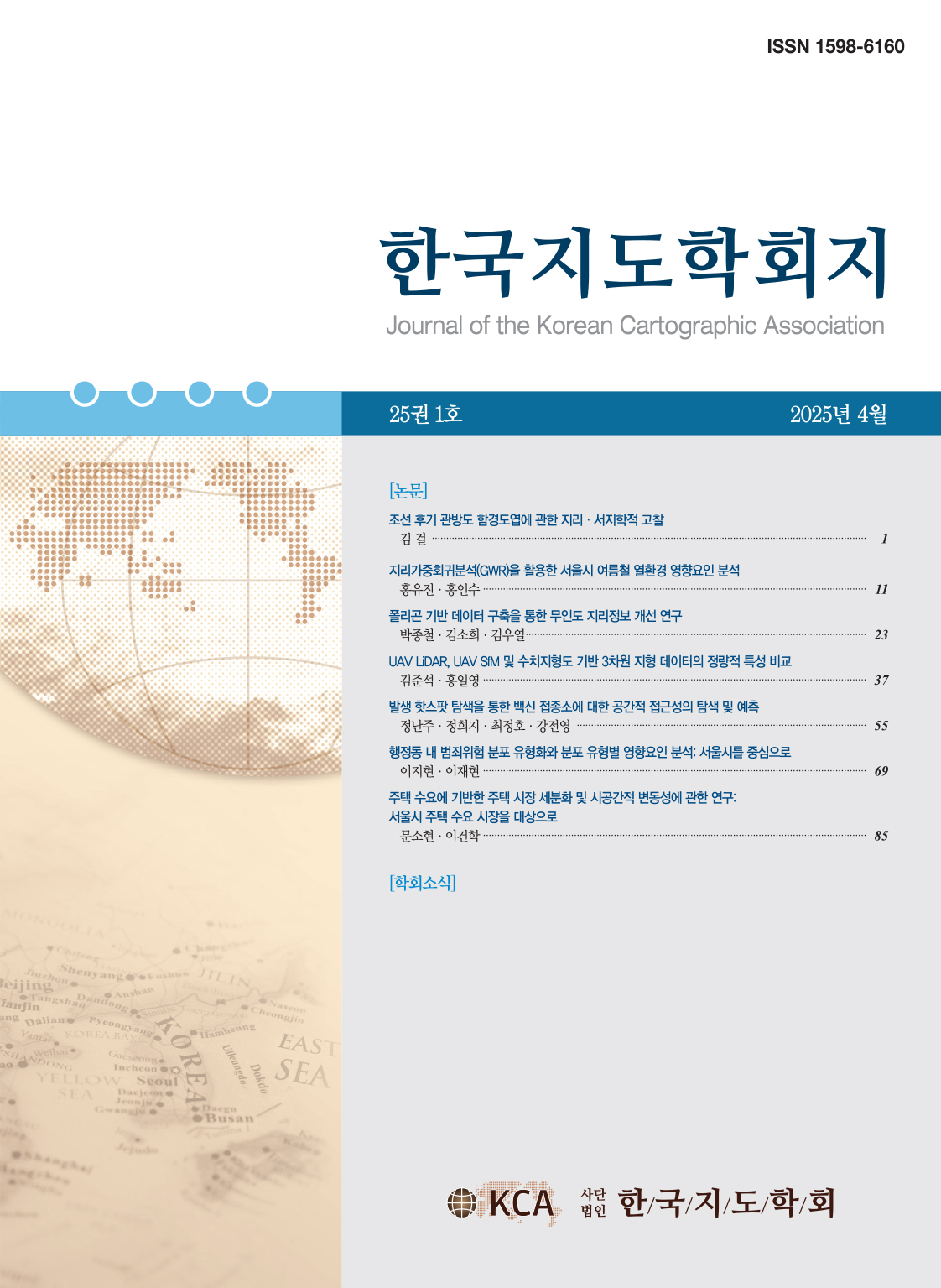Research Article
Abstract
References
Information
This study aims to search the changes in the spatial distribution of nationwide local extinction risk in a macroscopic way, and visualize that of eup and myeon with high extinction risk in a microscopic way, using the local extinction risk index. Local extinction risk indexes were calculated in 2000, 2010, and 2020 nationwide, and time-series analyses were performed based on them. According to the results of calculating the local extinction risk index in 2000, 2010, and 2020, there was no extinction risk area in 2000, but 61 in 2010 and 103 in 2020 were identified. This means that the local extinction risk has been intensified rapidly nationwide for the past 20 years. In particular, in 2020, 62.1% of the total extinction risk areas were concentrated on the Gyeongsang and Jeolla province. In addition, 25 guns including Uiseong-gun , Gyeongsangbuk-do , had ranked on the top 10% of national extinction risks in 2000, 2010, and 2020. This suggests that the state of high extinction risk was attached to a specific area. According to the results of the analyses on the 12 high risk extinction guns by eup and myeon (the top 5% of nationwide extinction risk), all 138 eups and myeons were identified as the extinction risk areas. Most of the areas with high extinction risk were myeon that has been underdeveloped. This study will be a basis of population geography and cartography to correspond the era of the low growth and the population decrease.
이 연구의 목적은 지방소멸위험지수를 활용하여, 전국적인 거시적 지방소멸위험의 공간 분포 변화를 고찰하고, 상대적으로 소멸 고위험에 해당하는 읍·면에 대해 미시적인 인구 감소의 공간 분포를 시각화하는 데 있다. 이를 위해 2000년, 2010년, 2020년의 전국 시·군·구별 지방소멸위험지수를 산출하였고, 이를 토대로 시계열적인 변화를 고찰하였다. 2000년부터 2020년까지의 10년 단위 지방소멸위험지수 산출 결과, 2000년에는 소멸위험지역이 한 곳도 없었으나, 2010년에 61곳, 2020년에 103곳이 확인되었다. 이는 지방의 소멸위험이 최근 20년 간 전국적으로 급격하게 심화되었다는 것을 의미한다. 특히, 2020년에는 경상도와 전라도에 전체 소멸위험지역의 62.1%가 집중되었다. 또한, 경북 의성군 등 25개 지역은 2000년, 2010년, 2020년 모두 전국 지방소멸위험 상위 10%에 해당하였다. 이를 통해 소멸 고위험의 상태가 특정 지역에 고착화되어 있다는 점을 확인하였다. 소멸 고위험 12개 군(지방소멸위험 상위 5%)의 읍·면별 분석 결과, 해당 읍·면 138곳 모두 소멸위험지역으로 확인되었다. 소멸 고위험에 해당하는 지역은 대부분 면 지역이었으며, 저개발 상태에 머물러 있었다. 이 연구는 저성장·인구 감소 시대에 대응하는 인구지리 및 지도학 연구의 토대가 될 것이다.
- 강인호・이영철・염대봉, 2015, "도시 수축: 도시재생의 새로운 패러다임," 한국사회와 행정연구, 26(3), 25-50.
- 고문익, 2021, "한국의 지방소멸위험지수 분석과 시사점," 한국교원대학교 석사학위 논문.
- 구형수・김태환・이승욱・민범식, 2016, 저성장시대의 축소도시 실태와 정책방안 연구, 국토연구원.
- 김민호, 2020, "야간 인공조명 강도와 토지피복을 이용한 남한의 광역시도 인구추정," 한국지도학회지, 20(2), 13-24. 10.16879/jkca.2020.20.2.013
- 박지희, 2018, "공간통계기법을 활용한 학령인구의 순이동 추정," 한국지도학회지, 18(3), 77-90. 10.16879/jkca.2018.18.3.077
- 유선종・노민지, 2018, 지방소멸, 어디까지 왔나?, 매경출판.
- 이상호, 2016, 한국의 '지방소멸'에 관한 7가지 분석, 한국고용정보원.
- 이상호, 2018, 한국의 지방소멸 2018, 한국고용정보원.
- 이시형・김 걸, 2018, "격자분석 기법을 활용한 공주시의 축소도시 사례 연구," 한국도시지리학회지, 21(3), 35-46. 10.21189/JKUGS.21.3.3
- 임석회, 2019, "지방소도시의 인구감소 및 성장과 쇠퇴의 특성," 대한지리학회지, 54(3), 365-386.
- 조대헌, 2020, "중소도시의 내부 인구이동과 주택시장 간의 연관성 분석: 강릉시 사례 연구," 한국지도학회지, 20(2), 71-85. 10.16879/jkca.2020.20.2.071
- 최재헌・박판기, 2020, "한국 축소도시의 지역적 특성과 도시정책의 방향," 한국도시지리학회지, 23(2), 1-13. 10.21189/JKUGS.23.2.1
- 増田寛也, 2014, 김정환 역, 지방소멸, 와이즈베리.
- Großmann, K., Hasse, A., Rink, D., and Steinführer, A., 2008, Urban shrinkage in East Central Europe? Benefit and limits of a cross-national transfer of research approaches, in Nowak, M. and Zachodni, I. eds.,
Declining Cities/Developing Cities: Polish and German Perspectives , 77-99, Poznan, Instytut Zachodni. - Haase, A., Rink, D., Großmann, K., Bernt, M., and Mykhnenko. V., 2014, Conceptualizing urban shrinkage,
Environment and Planning A , 46(7), 1519-1534. 10.1068/a46269 - Häußermann, H., and Siebel, W., 1988, Die schrumpfende Stadt und die Stadsoziologie, in Friedriches, J. ed., Soziologhische Stadtforschung,
Kölner Zeitschrift für Sozioligie und Sozialpsychologie , 29, 78-94. 10.1007/978-3-322-83617-5_5 - Hollstein, L., 2014,
Planning Decisions for Vacant Lots In the Context of Shrinking Cities: A survey and Comparison of Practices in the United States , Doctoral Thesis, Austin. - Martinez-Fernandez, C., Audirac, I., Fol, S., and Cunningham-Sabot E., 2012, Shrinking cities: Urban challenges of globalization,
International Journal of Urban and Regional Research , 36(2), 213-225. 10.1111/j.1468-2427.2011.01092.x 22518881 - Schilling, J., and Logan, J., 2008, Greening the rust belt: A green infrastructure model for right sizing America's shrinking cities,
Journal of the American Planning Association , 74(4), 451-466. 10.1080/01944360802354956 - 국가통계포털 주민등록인구(http://kosis.kr), 각 년도.
- Publisher :The Korean Cartographic Association
- Publisher(Ko) :한국지도학회
- Journal Title :Journal of the Korean Cartographic Association
- Journal Title(Ko) :한국지도학회지
- Volume : 21
- No :1
- Pages :65-74
- DOI :https://doi.org/10.16879/jkca.2021.21.1.065



 Journal of the Korean Cartographic Association
Journal of the Korean Cartographic Association





